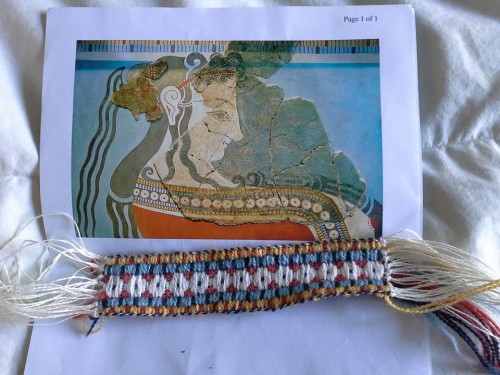Challenge #4 of the Historical Food Fortnightly is Foreign Foods. Sicily is "foreign" to me since I live in New Zealand, but it appears that Sicilian cooking methods were also decidedly foreign to the fourth century Greeks. The Greek writer Archestratus complained about Sicilian cooks' habit of ruining good fish with cheese.
Naturally, this was a matter of opinion. Neill from Pass the Garum (a blog I highly recommend!) has tried Sicilian-style fish with cheese and thought it was delicious. I will admit the dish doesn't necessarily look very delicious, though I think better presentation and a bit more time under the grill would help there, but I agree with Neill. This recipe is tasty.
The recipe is pretty simple: "After [the fish] has been thoroughly covered with cheese and oil, take it and hang it in a hot oven and bake it to a turn." The fish in question is a parrot fish, but I have never seen parrot fish for sale so I used hoki fillets, baked on baking paper in a modern electric oven.
I don't know what cheese Archestratus was using, but what I used was *ahem* Mainland Tasty Cheddar. It's what I had in the fridge. It also crumbles nicely in a pestle and mortar, and I mixed about a quarter of a cup of this crumbled cheese to a paste with a bit of olive oil. I smeared it on the fish fillets and baked them at 220 degrees C for 20 minutes, plus a little time under the grill to brown the cheese.
The Challenge: Foreign Foods
The Recipe: Archestratus fragment 13, as preserved in Athenaios' Deipnosophistai.
The Date/Year and Region: Sicily, fourth century BCE.
How Did You Make It: As described in this post.
Time to complete: About 40 minutes, all up.
Total Cost: None; I used ingredients I already had on hand.
How Successful Was It? In the sense that it tasted good and I will definitely make it again, it was highly successful. In the historical accuracy sense it was less successful, because I didn't use the same ingredients and cooking methods that the fourth century Sicilians used.
How Accurate Is It? The basic idea is accurate, but the ingredients are not quite what Archestratus had in mind.
Naturally, this was a matter of opinion. Neill from Pass the Garum (a blog I highly recommend!) has tried Sicilian-style fish with cheese and thought it was delicious. I will admit the dish doesn't necessarily look very delicious, though I think better presentation and a bit more time under the grill would help there, but I agree with Neill. This recipe is tasty.
The recipe is pretty simple: "After [the fish] has been thoroughly covered with cheese and oil, take it and hang it in a hot oven and bake it to a turn." The fish in question is a parrot fish, but I have never seen parrot fish for sale so I used hoki fillets, baked on baking paper in a modern electric oven.
I don't know what cheese Archestratus was using, but what I used was *ahem* Mainland Tasty Cheddar. It's what I had in the fridge. It also crumbles nicely in a pestle and mortar, and I mixed about a quarter of a cup of this crumbled cheese to a paste with a bit of olive oil. I smeared it on the fish fillets and baked them at 220 degrees C for 20 minutes, plus a little time under the grill to brown the cheese.
The Challenge: Foreign Foods
The Recipe: Archestratus fragment 13, as preserved in Athenaios' Deipnosophistai.
The Date/Year and Region: Sicily, fourth century BCE.
How Did You Make It: As described in this post.
Time to complete: About 40 minutes, all up.
Total Cost: None; I used ingredients I already had on hand.
How Successful Was It? In the sense that it tasted good and I will definitely make it again, it was highly successful. In the historical accuracy sense it was less successful, because I didn't use the same ingredients and cooking methods that the fourth century Sicilians used.
How Accurate Is It? The basic idea is accurate, but the ingredients are not quite what Archestratus had in mind.




